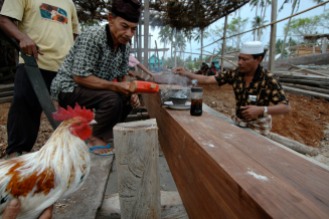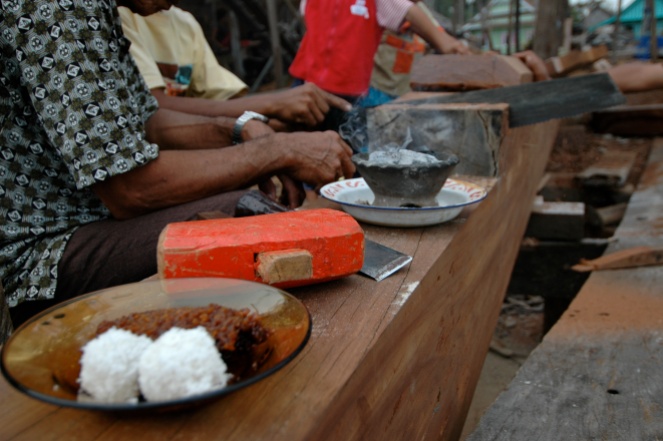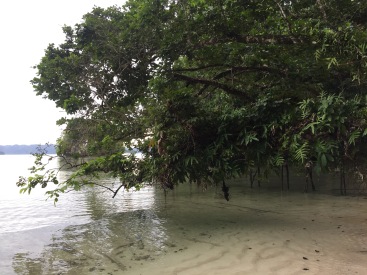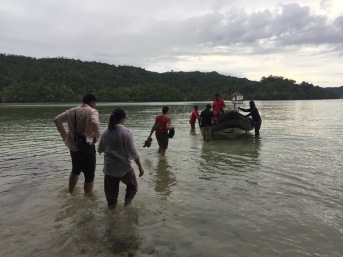
Phinisi- The Indonesian Art of Boat Building

The phinisi, a maritime icon of South Sulawesi & of the Indonesian seas, is a traditional & wooden boat, with two masts & seven sails. She is long & slender in style with an elegantly upward reaching prow. Also known by some as a ‘bugis boat’, the phinisi boat building craft is historically centered in the Bulukumba Regency of South Sulawesi, the residents being mainly of Buginese and Makassarese descent. They are still used for coastal & inter-island cargo transportation & fishing. More recently the phinisi have been adapted for use as ‘liveaboard” cruise charter boats in the dive and slow travel tourism sector, particularly in the remote Eastern islands of Indonesia.

Voyage by phinisi is by far, one of the most satisfying ways to travel through these remote places. The experience takes you back in time & to a pace of travel so opposite to what we have in the ‘modern’ world today. Travel on these phinisi makes you realise that life is more than being bound to technology & a fast stressful life. It immerses you into the natural elements, reviving sleepy & forgotten instincts between your human spirit & the sea, weather & the land. As you sit on the bowsprit of one of these vessels, you fill with a real sense of anticipation as you approach land, & realise the vastness, strength & life within our seas.
In December 2017, I was thrilled at the designation by UNESCO, of Phinisi boatbuilding as an Indonesian ‘Masterpiece of Oral & Intangible Heritage of Humanity’. This is a wonderful acknowledgment of not only the beauty & sea worthiness of this all wooden boat, but a huge appreciation of the skill of the craftsmen who have built her on beaches in South Sulawesi for centuries. The skill has traditionally been passed down from generation to generation.
Fewer & fewer phinisi craftsmen are working on the coconut fringed sands of Bulukumba today & there is concern that this maritime tradition will fade as less interest is shown by the younger generation. Raw materials in the form of specialized timber is also a challenge. There are legal issues over the importation & sustainability of the timber from other regions, namely Southeast Sulawesi, Maluku, Kalimantan & Papua. The timber used has to be mature & of good size in order to carve out the keels, prows & ribs of these boats. Hopefully, this listing will ensure that phinisi will live on as a tangible form of sea trade & travel, & will encourage the younger generations of craftsmen to continue building these craft on the beaches of South Sulawesi.
In 2007, whilst based in Jakarta, my husband & I, with another family as partners, decided to build a phinisi on Bira Beach. We designed Tiger Blue as a liveaboard phinisi & we wanted to embark on voyages of discovery & adventure with lots of diving, around the islands of Eastern Indonesia. Our idea was to design her so that she would accommodate our families & guests, cater to mixed age groups, a range of activities & to provide spaces more than just an all dive boat. We wanted plenty of deck space, large deck beds, a great big dining table & areas so that people could spread out & do their own thing whilst voyaging on her. The master builder in Bira, Haji Abdullah took a year to complete the build.
The basic aesthetics of Tiger Blue was designed by my husband David Wilkinson & the late Wouter van den Houten. We’d met Wouter when we had chartered a trip on his own phinisi ‘Majestic’ before making the decision to build Tiger Blue. After the eight day charter with Wouter, we shook hands as friends & he then managed the whole build for us in Bira. Wouter specialised in the mechanical, engineering & maritime elements of Tiger Blue. He was a great sailor & it was brilliant to have had his expertise & passion for Indonesia, its boats & its islands with us as we all went through the process of building Tiger Blue. We couldn’t have done this project without Wouter. However, every step we took we did in collaboration with Haji Abdullah. His skill & spirit as the phinisi maker, was obvious right from start. He somehow breathed the life into the timbers of Tiger Blue. A real project of passion & camaraderie, we really did create a very beautiful ship, steady & strong & in love with the sea.
Haji Abdullah, at the final stage of Tiger Blue being winched down the beach into the sea, announced that the whole build had been extremely smooth. It had been one of his best experiences with no hitches & that all through it he said, Tiger Blue, she seemed impatient to get into the sea. It was a wonderful way to describe her incarnation from a specially chosen keel timber on the sand to her completed hull being launched into the sea from the beach in Bira.
Haji Abdullah has retired from commercial phinisi building but is still working on special boat building projects in Bira. It would be a real loss to this masterful art of boatbuilding if he retired completely. There would be one less phinisi master craftman working to keep these skills alive.
It has been a real privilege to have been part of this collaboration & it will forever be forged in my mind & memories. The building of Tiger Blue was personally, one of my most life changing experiences. I was terrified of the sea before, not a strong swimmer & with no control over my instincts & fear of it. I have in most part, come to terms with these fears mainly because the voyages around Eastern Indonesian can only be described as magical. Its good to have fear, it keeps you alert but life is a journey of learning & tolerance, & where one should occasionally be thrown out of one’s own comfort zone. It is also a journey where we should take every opportunity to soak in what is around us in this world. We can’t do everything, but with a phinisi, we can marvel at the archipelago that is Indonesia, its myriad seas, its people & natural beauty.
At the most important stages of the build there are rituals, incantations, ceremony & the calling up of spirits. The laying down of the keel timber is the first stage. We went specially to Bira for the ceremony of the laying of the keel timber.
Haji Abdullah was there to greet us, as were all the boatbuilders working on Tiger blue, with their families. Offerings of food had been made & laid out on the long keel timber. We all waited for the bomoh to arrive. He brought with him a very fine cockeral. Too fine to be sacrificed we hoped. It was tied by its leg to one of the pieces of wood while proceedings took place.
The blessing of the keel timber was important. It ensures a good build, safety for all involved in the life of the boat, & later, for her safety on the sea.
With the food offerings all displayed, the tools used by all the craftsmen were also placed together on the keel. These comprised of a pile of axes, adzes & a couple of electrical drills & tools. They would all be blessed with good luck & prayers.
The bomoh & Haji Abdullah then took their positions. They squatted & kneeled, one on each side of the keel. The bomoh then lit incense & whispered prayers to the spirits. The cockerel was then brought forward & a little nick made in its comb with a knife. A tiny drop of its blood was dripped into the smoking incense charcoals. He was then held nearby to watch until the end of the proceedings. We all noted that it must have done this many times. The cockerel stood by with such confident poise as if it knew its position & importance in this ceremony.
Haji Abdullah then placed his hand on the end of one of the keel timbers, & the bomoh marked out a section on the end with a chisel & a wooden hammer. He marked a line & then sawed off the end of the whole beam. The bomoh then took this piece of wood, walked down to the beach & whilst uttering more prayers threw the piece of wood into the sea, a sacrifice to the spirits of the sea.
The bomoh returned to the front end of the keel & chiseled off the edge of the beam. A spoonful of food( a delicious coconut & palm sugar delicacy) was then placed on the end to feed the spirit of the keel. A pot of tea was then brought, blessed & Haji Abdullah poured tea over the timber. Once this feeding of the keel was complete, it was the turn of everyone else to eat & the ladies of the families came forward to distribute food to all of us. We took the plates & fruit from the keel & joined in the happy & chatty atmosphere. The blessing was complete.
The cockerel was tied back up while the bomoh ate his meal & then was unceremoniously grabbed by his feet & dangled off the hand of the bomoh for the walk home. His job done, it was back to being an ordinary cockerel until the next ceremony!
After the meal was finished everyone got back to work & the prow timber was winched & maneuvered into its place on the end of the keel.
Those builders not directly involved in the winching of the prow beam, sat aside with a log of the caulking timber, chopping into it & pulling out the strands of this fibrous wood, ready to start caulking the internal planks of the hull.
Tiger Blue’s keel, ribs & hull are of iron wood. There is a particular method in building a phinisi. They are built from the outside in. Once the keel timber is down, the hull timbers & planks are all set in place. Once the outer ‘skin’ of the phinisi is formed & shaped, the ribs are then added on the inside. This part of the build is fascinating because the builders almost ‘massage’ the ‘skin’ to fit against the ribs. At this stage the vessel looks like a great body with the internal cavern of a whale. Caulking is done with a particular tree bark. The internal structures are then added, & above it the decks & superstructure of are teak.
At the time, as I walked down the beach at Bira viewing these enormous craft being formed on the sands, I remember very clearly feeling that they were more than inanimate objects. They were being crafted & imbued with an ancient sense of strength, calm & serenity. As I wandered here, I really did think of ‘arks’, rather than ‘boats’. An ‘ark’ brings up such a different image in your head, & on the beach in Bira, ‘ark’ was more appropriate.
Tiger Blue took two months to be hand winched, inch by inch, down the beach into the water. The craftsmen & carpenters worked on her as she slowly went down the beach.
It was a wonderful day seeing her afloat for the first time.

The boat builders continued working on her until she was floating completely on her own, getting used to the water. She was then towed into Bira Harbour where worked continued.
Here the engine room was fitted out & on the day the engine was brought in, a goat was slaughtered in the engine room, a sacrifice to ensure that Tiger Blue voyages safely with all who travel on her. Afterwards, one of the goats legs was tied to the underside of the dive platform. It remained here until it fell away into the sea about a year later.
From Bira Harbour, we motored Tiger Blue to Makassar, where all the finishing, the electrics, plumbing, interiors were all finished off. It was here in Makassar that we also filled her with huge chunks of marble, her ballast.
Our whole family joined her on this sail from Bira to Makassar. We had dolphins at the bowsprit & it was a lovely sail. It took a couple more months of finishing before we were ready for the first charter. The few nights before the start, the crew, Wouter & I worked around the clock to get her ready for guests.
On the last evening I took out the various offerings I was advised to offer to the sea by the local fishermen on Pangkor Island, where we lived in Malaysia. Kneeling, I was to tie a red cloth tightly around the front most rigging on the bow sprit. I then had to make a small display & offering of food, cheroots, betel nut & incense & flowers. I was to then say a prayer to the sea, wishing to keep Tiger Blue & all on her safe from harm. May she voyage well & strong. I was to let the incense burn out & then throw all the offerings in as many directions as possible from the bow sprit. I did all this as our Indonesian crew watched, an extra ritual to keep them safe. Remnants of the red cloth stayed on the rigging up to just a couple of years ago.
Tiger Blue feels totally ‘alive’ on the sea, her spirit keeping us safe & steady through all sorts of weather, a great testimony to the men who crafted her on the beach in Bira. She is 10 years old this year & she continues to exude great spirit & energy to all the voyages we take on her. I love that every time I board her, I feel her come alive. Its an exhilarating & quite emotional connection.
Tiger Blue remains true & strong & in June this year, she will undergo a big maintenance schedule & a new major fit out that will see the cabins & bathrooms upgraded, ready for the next season of charters & voyages of discovery along the Spice & Wallace Routes.
Join a voyage of discovery with Tiger Blue.
Website: <www.tigerblue.info>
Email: <sail@tigerblue.info>
Tiger Blue Instagram: @sailtigerblue
Tiger Blue, Voyage Indonesia Facebook: @sailtigerblue https://www.facebook.com/sailtigerblue/
Note: If in Jakarta take the time to go to Sunda Kelapa where you can still view the traditional ‘working’ phinisi, in both the ‘lamba’ (straight stern) & “palari’(curved stern) styles. Here in these busy docks, the phinis are unloaded & loaded with goods that will be trans-shipped all around the Indonesian archipelago. The scene is reminiscent of an olden day harbour, busy with men hauling sacks & large packages boxes on shoulders, running up gang planks onto decks & disappearing into the large holds of the boats.
























































































































